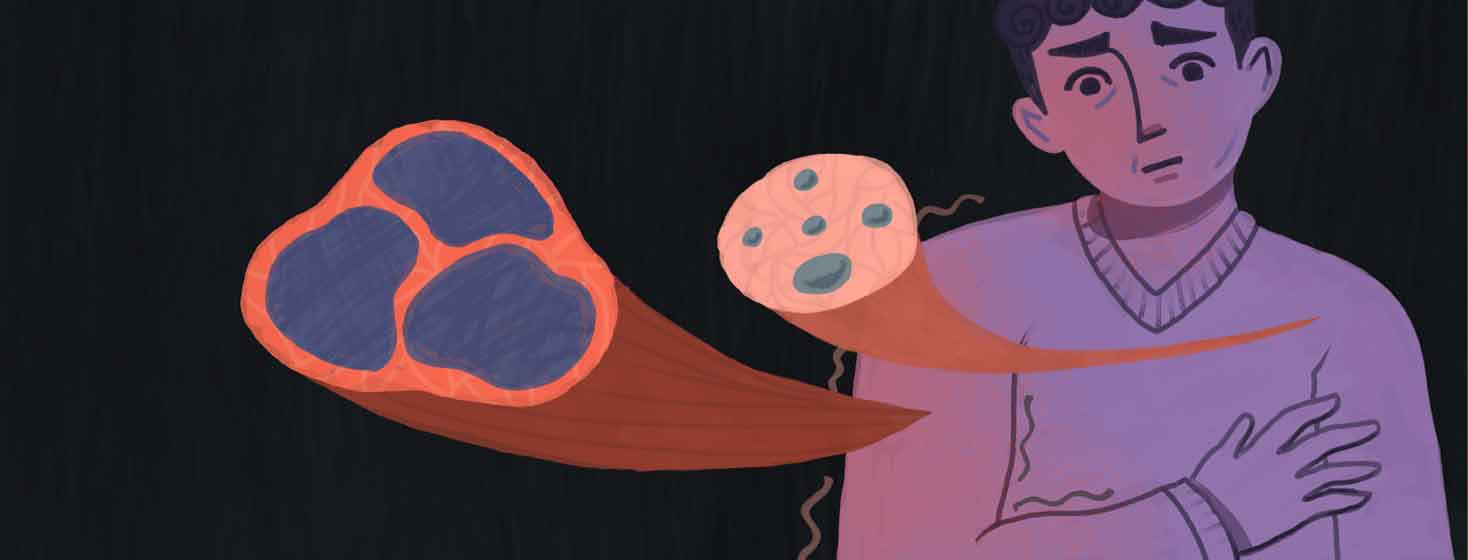Pompe Disease: What You Need to Know
Reviewed by: HU Medical Review Board | Last reviewed: January 2023 | Last updated: May 2025
Pompe disease is a rare genetic condition that affects the muscles that connect to your bones and heart. It is also called glycogen storage disease II, acid-maltase deficiency, or acid alpha-glucosidase deficiency.1-4
What is Pompe disease?
People with Pompe disease have a problem in their lysosomes. Lysosomes are parts of cells where many important functions take place. These functions include breaking down waste, viruses, and bacteria. Lysosomes also help recycle compounds the body needs, like sugar. Your body needs sugar for energy.1,5
Within lysosomes, your body joins and stores sugar molecules in a form called glycogen. When your body needs extra energy, it breaks down the glycogen and releases the sugars. Proteins called enzymes help with this breakdown. One of these proteins is called acid alpha-glucosidase (GAA).1-4
In people with Pompe disease, GAA does not work as it should. They have either no GAA at all or a limited amount. Without GAA, their bodies cannot break down glycogen, so it builds up. This buildup occurs in muscle cells, like those in the skeletal muscles and the heart. This can lead to muscle weakness and heart failure.1
Changes in a person’s genes, known as genetic mutations, can lead to low or no GAA production.1
Who gets Pompe disease?
Pompe disease is a rare condition. It affects around 1 in every 40,000 people in the United States. There are many types of genetic mutations that can lead to Pompe disease. Some lead to more severe Pompe disease than others.1-4
There are 2 main types of Pompe disease: infantile-onset and late-onset. Infantile-onset is more severe and occurs in babies with very little to no GAA. It is also called "classic" Pompe disease. Babies with classic Pompe disease start showing symptoms in the first few months of life.1,4,6
Late-onset Pompe disease can vary based on the type of gene mutation a person has. Different mutations lead to different amounts of working GAA. Some people start showing symptoms in childhood, while others may not show any symptoms until they are 50 or 60 years old.1,4,6
What does it mean to be a carrier?
Pompe disease is an autosomal recessive genetic disorder. This describes how the disease is passed on through families. Genes come in sets of 2, one from the mother and one from the father. In recessive genetic disorders, both genes in a set must be mutated to cause the disease.7
People can be carriers of Pompe disease. This means they have a copy of a mutated gene but do not have the condition. Their non-mutated gene makes enough GAA to carry out its functions.1,4
Many people do not know they are a carrier. But if 2 carriers have a baby and each pass down their mutated gene, the baby will have Pompe disease.1,4
How is Pompe disease diagnosed?
Some states test for Pompe disease as a part of their newborn screening process. This involves testing a dried spot of blood taken shortly after birth to look for certain health issues. Early diagnosis and treatment can help babies live better lives.1
Aside from newborn screening (and for babies who screen positive and need further testing), there also are other blood tests used for diagnosis. The main way to diagnose Pompe disease is through measuring GAA activity in a blood sample. Both infantile and late-onset Pompe disease can be diagnosed by measuring GAA activity.1,6
Other blood tests used in diagnosis look for markers of muscle breakdown, like creatinine kinase (CK) or lactate dehydrogenase (LDH).1
Once you are diagnosed, you can have genetic testing to find specific mutations in the genes that make GAA. Genetic testing is helpful in family planning for those who have or are carriers of Pompe disease.1
What are the symptoms of Pompe disease?
The symptoms of Pompe disease vary based on the type and amount of working GAA. Babies with infantile Pompe disease will have severe muscle weakness early in life. They can have an enlarged heart and eventually heart failure due to glycogen buildup. Babies with Pompe disease may also have:1,3,6
- Liver problems
- Breathing issues
- Trouble feeding
- Slow or no growth
- Large tongues
Late-onset Pompe disease has different symptoms. Symptoms can occur at any time and often do not involve the heart. People with late-onset Pompe disease may have:1-4,6
- Trouble breathing and delays in motor development (primarily in children)
- Muscle weakness around their hips, upper legs, and upper arms (limb-girdle muscle weakness)
- Digestive issues, including swallowing or bowel problems
How is Pompe disease treated?
Pompe disease is best treated by a team of healthcare specialists. Doctors that focus on the heart, lungs, nervous system, and genetic disorders are often involved. Other experts like dietitians and physical therapists can be helpful too.3
Right now, there is no cure for Pompe disease. However, there are drugs that can help slow its progression and improve symptoms. These drugs include:1-3,8
Enzyme replacement therapies (ERT)
These are human-made forms of the GAA enzyme. The specific ERT drug used depends on the type of Pompe disease a person has. Examples include alglucosidase alfa and alglucosidase alfa.1-3
Combination therapy
The US Food and Drug Administration (FDA) has approved the first and only combination therapy for people with late-onset Pompe disease. It is approved for adults who have not seen results with ERT drugs. This 2-component therapy includes an enzyme replacement therapy called cipaglucosidase alfa-atga (Pombiliti™) and an enzyme stabilizer called miglustat (Opfolda™).8
Early diagnosis and treatment can help manage the symptoms of Pompe disease and extend people's lives. Along with appropriate treatment, exercise and diet can play a role in the management of Pompe disease and its symptoms. And newer treatments like gene therapy and new forms of ERT are currently being studied. While these forms of treatment are not yet approved, the outlook is hopeful.1,3

Join the conversation